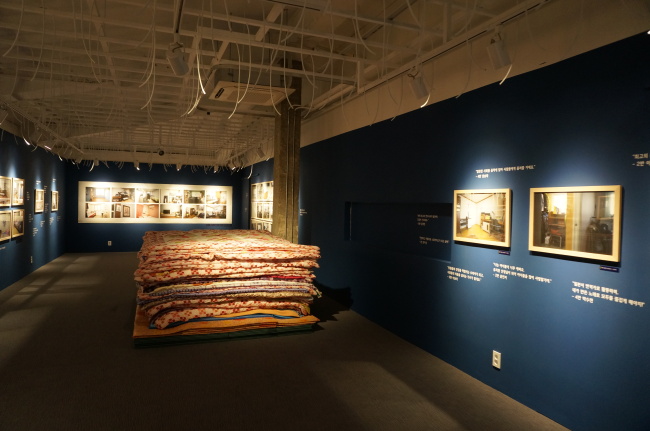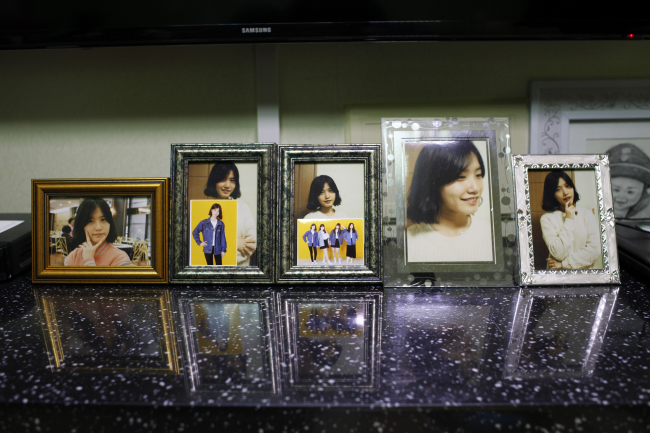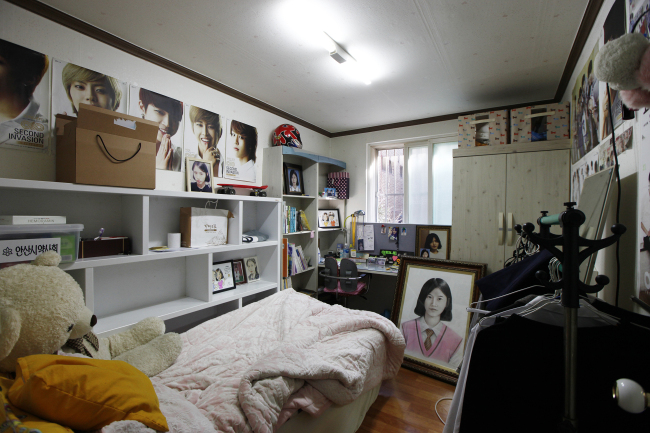Keeping records of Sewol sinking
Grassroots movement to collect records of the maritime disaster marks first anniversary with touring exhibition
By Lee Woo-youngPublished : April 8, 2015 - 19:46
Posters of a K-pop boy band and a big stuffed bear imply the owner of the room must be a teenage girl. Indeed, sitting at the center of the room is a large portrait of a girl with the typical look of a Korean high school student with short, straight hair. But she hasn’t been home since April 16, 2014.
Seventeen-year-old Danwon High School sophomore Han Se-young was one of the 304 who perished when the Sewol ferry sank off the southern coast of Korea. She was on a school trip to Jejudo Island, with 325 fellow students from her school in Ansan, Gyeonggi Province.
Seventeen-year-old Danwon High School sophomore Han Se-young was one of the 304 who perished when the Sewol ferry sank off the southern coast of Korea. She was on a school trip to Jejudo Island, with 325 fellow students from her school in Ansan, Gyeonggi Province.

The photo of her room is one of 54 heartbreaking pictures of rooms that used to belong to student victims of the ferry disaster, currently on display at an exhibition in Ansan.
It is also the first of a series of exhibitions and publications featuring records of the Sewol ferry sinking, its aftermath and impact on Korean society, which will soon mark the first anniversary of the tragedy.
“This is the result of our self-examination. We can’t just let this tragedy be forgotten easily,” said Kwon Yong-chan, director of “416 Memory Storage,” an archival project for the Sewol ferry disaster.
Memories and lessons from past man-made disasters easily faded away, Kwon said, as people get on with their lives. Some call this a culture of forgetting and a key characteristic of Korean society.

“This is different. We can’t let that happen again,” he said.
The 416 Memory Storage began as a voluntary movement by people who realized the importance of record keeping when the country was paralyzed in the aftermath of shock, grief and anger.
A team of archival science graduate students and professors of Myongji University, including Kwon, were among the first to head to Jindo Island, where search operations and daily government briefings took place.
They set up a tent next to the Jindo Indoor Stadium, a temporary shelter where victims’ families awaited the return of their loved ones, and started collecting and recording everything happening there.
“We collected every record, including the daily situation reports produced and discarded by the central research operation team. We also gathered interviews of volunteers about how families were dealing with the situation, as well as responses of the government and press to the accident,” said Kwon.

Other teams were on a mission in Ansan, home for most of the student victims, and in Seoul where a huge memorial service was held in front of Seoul City Hall.
Those efforts separately continued until August last year until a central entity, “416 Memory Storage,” was formed, which now operates under the group of victims’ families.
The archival project has had four main focuses ― governmental records related to the ferry disaster; activities of victims’ family members; records of victims; and memorial services.
The photo project for the exhibition was initiated as a way of collecting records of the victims.
Sixteen professional documentary photographers volunteered to take photos of the rooms of student victims, who made up most of the passengers aboard the sunken ferry.
A team of four ― a photographer, a writer and two archivists ― visited the homes of 100 student victims since November last year. The writer wrote down stories of children as told by parents. Meanwhile, the photographer took pictures of their room and archivists scanned childhood photos and any notable records of victims and converted them into digital files.
At the exhibition, excerpts of parents’ testimonies are written on the wall alongside the photos. They are promises and wishes exchanged between parents and their loved ones.
“Mom, the cherry blossoms are so beautiful. Let’s go see them next year,” reads one of them.
University photo major Kim Min-ho joined the photo project alongside veteran photographers, including Noh Sun-tag, chosen as the Artist of the Year by the National Museum of Modern and Contemporary Art, Korea.
“I remember every room I took. Every room was different just like the students’,” said Kim. “I tried to take rooms as they were because they showed how they lived and their personalities.”
More photos are on display in Seoul from April 7-19 and on Jejudo Island throughout the year.
In the exhibition space, there are piles of blankets, floor mattresses and covers used by victims’ families in the indoor stadium for eight months.
“The blankets hold the sorrows of parents and their endless wait of their beloved ones. We decided to include them in the archive permanently and show them in the exhibition,” said Kwon.
The exhibition opening Thursday afternoon began with a moment of silence for victims at 4:16 p.m. But family members didn’t attend the ceremony as most of them headed to the protest site. Some shaved their heads in a show of protest over the government’s announcement to start the compensation process instead of launching an investigation into the cause of the tragedy.
The blankets were also sent to the protest site in Gwanghwamun, Seoul, for parents who resumed a long sit-in against the government.
Choi Yoon-a, sister of one of the student victims, came to the opening with a small pot of yellow chrysanthemums.
“I came to see the photo of my sister’s room,” said the 25-year-old. “I don’t think I could do much at the protest other than cry, so I came here to do something I can do.”
She placed the flower pot in front of the picture of her sister’s room. The card she wrote read “Choi Yoon-min, our family, we all love you.”
By Lee Woo-young (wylee@heraldcorp.com)








![[KH Explains] Hyundai's full hybrid edge to pay off amid slow transition to pure EVs](http://res.heraldm.com/phpwas/restmb_idxmake.php?idx=644&simg=/content/image/2024/04/18/20240418050645_0.jpg&u=20240419100350)






![[From the Scene] Monks, Buddhists hail return of remains of Buddhas](http://res.heraldm.com/phpwas/restmb_idxmake.php?idx=652&simg=/content/image/2024/04/19/20240419050617_0.jpg&u=20240419175937)

![[KH Explains] Hyundai's full hybrid edge to pay off amid slow transition to pure EVs](http://res.heraldm.com/phpwas/restmb_idxmake.php?idx=652&simg=/content/image/2024/04/18/20240418050645_0.jpg&u=20240419100350)

![[Today’s K-pop] Illit drops debut single remix](http://res.heraldm.com/phpwas/restmb_idxmake.php?idx=642&simg=/content/image/2024/04/19/20240419050612_0.jpg&u=)